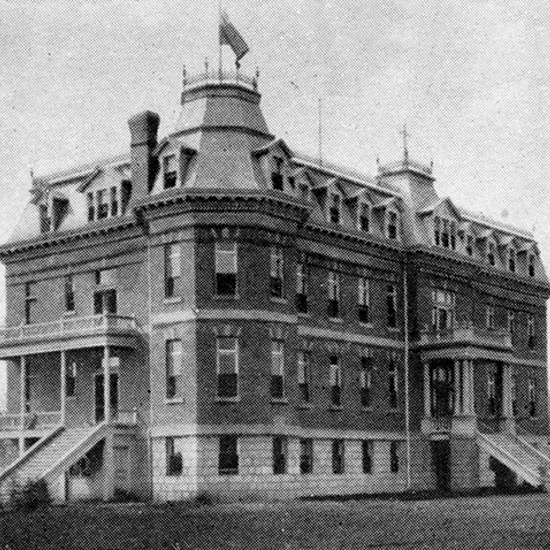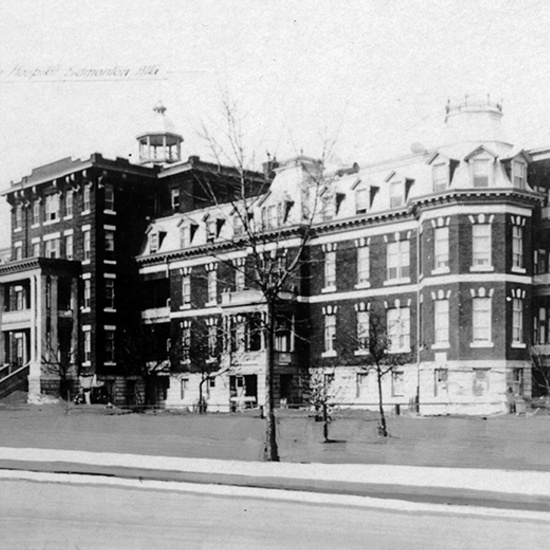Misericordia Hospital
Four sisters and one nurse from Quebec arrived in Edmonton in 1900 to establish the Misericordia Hospital on 111th Street.
Four sisters and one nurse from Quebec arrived in Edmonton in 1900 to establish the Misericordia Hospital on 111th Street.
These women, Sister St. Françios D’Assise (Mother Superior), Sister St. Laurent, Sister St. Rose de Lima, Sister St. Frederic, and nurse Mary Jane Kennedy, responded to the call from Bishop Grandin of the St. Albert Diocese to build a mission in the community of 3,000 that was Edmonton at the time. They set out to care for unwed mothers and their babies, at first in a four-room warehouse owned by Norris and Carey on the southwest corner of 111th Street and 98th Avenue. This mission complemented the nearby General Hospital, which opened five years earlier. Local need was high, and the work of the sisters quickly expanded beyond its original mandate to be a multi-purpose hospital, orphanage, and boarding residence.
The sisters built this 60-bed hospital on 111th Street between 98th and 99th Avenue in 1906. Designed by J.A. Senecal of Manitoba, the three storey brick building was fashioned in the Second Empire style of architecture. This French genre, brought to Canada from the Second Empire in France of Napoleon III, features the high windows with elaborate mouldings, the mansard roof with gabled dormer windows, the iron cresting, and the corner turret seen on the original Misericordia Hospital. The building also had contrasting rusticated stone on the lowest level, elaborate voussoirs with contrasting keystones above the single sash windows, a stone band between the first and second storey, and a dentilled cornice below the third level. The main entrance and south façades featured porches with Tuscan columns and an architrave supporting a second level balcony. The hospital had a basement with kitchen, laundry, and furnace facilities. Administration offices, a chapel, a dispensary, and a general operating room were located on the main floor. The maternity ward was on the second level, which also contained a separate kitchen and operating room. The third floor housed two wards for male patients.
One year after their hospital opened, the Misericordia sisters began a school of nursing, graduating their first three students in 1910. This school had over 2,800 graduates in its 89 year history, finally closing its doors in 1996.
The hospital developed alongside the growing city. A sunroom was added to the south façade in 1914, and architect Edward Underwood designed an extension to the north of the building in 1922, effectively doubling the bed capacity to 175. A two storey nursing residence was built in 1936 and a 126 bed maternity wing added in 1940, designed by architects Rule and Wynn. In 1949 a new nurses building consolidated the school and residence under one roof. Then in 1952, a new east addition and front entrance was built, designed by architects Rule, Wynn, and Rule. At a cost of $500,000 this addition was five-storeys tall and housed 61 beds. It was clad in red brick, with a copper canopy covering the entryway. Raised white lettering spelled out the hospital’s name in French and English. The same architects drew up the plans for a west wing to be built three years later. Similar in design to the east wing, and costing $760,000, the five storey addition had eight operating suites on the top floor, men’s and children’s wards with 82 beds, kitchen facilities, and living space for the Misericordia sisters. In total the hospital had room for over 400 patients.
The aging facility began to close down starting in 1959. Five years later a fire damaged the structure after a boiler explosion. The entire hospital moved to a new facility in the west end of Edmonton in 1969. By 1972 only the east and west wings of the first hospital complex remained, housing mentally disabled children for a short time before the whole building was eventually torn down.
Details
Type
Governmental
Designation Status
Demolished
Neighbourhood
Time Period
Year Built
1906
Architects
Gordon Wynn
Peter Rule
John Rule
J. A. Senecal
Edward Underwood
Architectural Styles
Character Defining Elements
Balcony , Banding , Brick structure , Columns , Cornice , Cupola , Dentil , Dormer , Keystone , Mansard roof , Plinth , Rectangular footprint , Three storeys or more , Turret , Voussoirs

